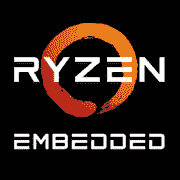AMD Ryzen Embedded R2314

AMD Ryzen Embedded R2314: Detailed Review of the Processor for Embedded Systems and Compact Solutions
March 2025
Key Features: Picasso Architecture and Main Characteristics
The AMD Ryzen Embedded R2314 processor, released under the codename Picasso, is positioned as an energy-efficient solution for embedded systems, media centers, and light workloads. Built on a 12nm manufacturing process, the chip features 4 cores and 4 threads (without SMT support), making it ideal for low-power scenarios.
Key Specifications:
- Architecture: Zen+ (optimized for embedded systems).
- Frequency: Base — 2.3 GHz, Maximum — 3.5 GHz (exact values depend on workload).
- Cache: L3 — 4 MB, L2 — 2 MB.
- TDP: 15 W, with the option to be adjusted in BIOS down to 12 W.
- Graphics: Radeon Vega 6 (384 shader processors, frequency up to 1100 MHz).
- Performance: Geekbench 6 — 975 (single-core), 2314 (multi-core).
Features:
- Support for AMD SenseMI technologies for power consumption optimization.
- Hardware video acceleration (H.265/HEVC, VP9) for media tasks.
- Extended support for industrial interfaces (CAN, GPIO).
Compatible Motherboards: Sockets and Chipsets
The Ryzen Embedded R2314 uses the FP5 (BGA) socket, which means it is integrated into motherboards during manufacturing. This limits user choices but simplifies the design of compact systems.
Recommended Boards:
- ASRock IMB-R2314: AMD XFP5 chipset, 2 SO-DIMM DDR4 slots, HDMI 2.0, 4x USB 3.2 Gen2. Price — $180–$220.
- ASUS EPC-R2314: Promontory LP chipset, M.2 NVMe support, 2x Gigabit Ethernet. Price — $200–$240.
Selection Tips:
- For industrial tasks, look for boards with ECC memory support and advanced interfaces (COM ports, SATA III).
- In media centers, HDMI 2.0 and DisplayPort output are crucial.
Supported Memory: DDR4 and Dual-Channel Mode
The processor works with DDR4-2400/2666 MHz in dual-channel configuration. The maximum capacity is 64 GB (2x32 GB).
Recommendations:
- For embedded systems: 8–16 GB (e.g., Crucial SO-DIMM DDR4-2666).
- For data buffering tasks: 32 GB (Kingston KVR26S19D8/32).
ECC memory is supported but requires a compatible motherboard.
Power Supplies: Minimum Watts — Maximum Efficiency
With a TDP of 15 W, the processor does not require a powerful power supply. Suitable for R2314-based systems:
- Passive Solutions: PicoPSU-90 (90 W, $60–$80) — for silent media centers.
- Standard PSUs: Seasonic SSP-300TG (300 W, $45) — with a buffer for peripherals.
Important: In industrial systems, use a PSU with an 80+ Platinum certification for stability.
Pros and Cons: Who is the R2314 Suitable For?
Advantages:
1. Low power consumption and passive cooling.
2. Integrated Vega 6 graphics for 4K video and light gaming.
3. Reliability (operating temperature up to 105°C).
4. Support for ECC memory for critical tasks.
Disadvantages:
1. No multithreading (4 threads compared to 8 in Ryzen 5 3400G).
2. Limited upgradeability (BGA socket).
3. Weak overclocking potential.
Use Scenarios: From Digital Signage to Home Servers
1. Industrial Systems: Management of IoT devices, sensor control.
Example: At a Bosch factory, R2314 processors are used for monitoring conveyor lines.
2. Media Centers: 4K HDR video via Kodi or Plex.
Example: A Reddit user built an HTPC on R2314 with Ubuntu, spending $300 on the entire build.
3. Office Tasks: Document work, browsing, video conferencing.
4. Light Gaming: Dota 2 on medium settings (720p, 40–50 FPS), Stardew Valley.
Comparison with Competitors: Intel vs. AMD
Intel Celeron J6412:
- 4 cores, 4 threads, UHD graphics 16 EU.
- Geekbench 6: 890 (Single), 2100 (Multi).
- Price: $120.
Conclusion: R2314 wins in graphics and ECC support.
AMD Athlon 3150U:
- 2 cores, 4 threads, Vega 3.
- Geekbench 6: 950 (Single), 1900 (Multi).
- Price: $130.
Conclusion: R2314 better in multithreading and memory.
Practical Assembly Tips
1. Case: Choose compact solutions (Streacom F1C WS, $80).
2. Cooling: Passive cooler NoFan CR-80EH ($40).
3. Storage: M.2 NVMe 256 GB (WD Blue SN570, $35).
4. OS: Linux (Ubuntu LTS) for embedded tasks, Windows 11 IoT for media.
Final Conclusion: Who is the R2314 Suitable For?
The AMD Ryzen Embedded R2314 is a niche solution for:
- Engineers designing industrial systems with low TDP.
- Enthusiasts building silent media centers.
- Businesses deploying digital information panels.
The price of the processor as part of a motherboard ($200–$300) is justified for projects where reliability and energy efficiency are paramount. If you need a processor for gaming or heavy software, consider the Ryzen 5 8600G. However, for its intended tasks, the R2314 remains an uncompromising choice.
Basic
CPU Specifications
Memory Specifications
GPU Specifications
Benchmarks
Compared to Other CPU
Share in social media
Or Link To Us
<a href="https://cputronic.com/en/cpu/amd-ryzen-embedded-r2314" target="_blank">AMD Ryzen Embedded R2314</a>